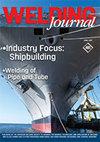焊后处理对搅拌摩擦焊接AlSi10Mg的影响
IF 1.4
3区 材料科学
Q2 METALLURGY & METALLURGICAL ENGINEERING
引用次数: 1
摘要
鉴于目前大多数增材制造(AM)机器的制造量有限,需要一种利用AM提供的独特功能并将其与传统制造方法相结合的方法。焊接am生产的部件是解决这一挑战的一种方法。本研究的目的是确定采用搅拌摩擦焊(FSW)连接激光粉末床熔合(PBF-L)熔化的AlSi10Mg的可行性,并研究焊后热处理(HT)和热等静压(HIP)对接头整体质量和力学性能的影响。使用光学显微镜、扫描电镜、硬度测试和拉伸测试对样品进行了检查。对经过焊后退火的样品进行检查,发现沿搅拌区和热机械影响区(TMAZ)边界有裂纹。根据材料规范,尽管退火温度比材料的固相温度低27°C(81°F),但对裂纹的检查显示,TMAZ中单相硅析出物附近有液化的证据。利用计算得到的AlSi10Mg的伪二元相图,确定了退火温度处于AlSi10Mg的部分液化状态。结果表明,孔洞和裂纹的形成机制是由本构液化和独特的TMAZ微观结构和应力状态共同作用的结果。实验结果表明,焊后和焊接后的板无空洞和缺陷,FSW是一种可行的连接PBF-L铝合金的方法,其抗拉强度最小。本文章由计算机程序翻译,如有差异,请以英文原文为准。
The Effects of Postweld Processing on Friction Stir Welded, Additive Manufactured AlSi10Mg
Given the limited build volumes for most current additive manufacturing (AM) machines, a method for taking advantage of the unique capabilities offered by AM while combining it with traditional manufacturing methods is needed. Welding of AM-produced components is a solution to this challenge. The objective of this study was to determine the feasibility of using friction stir welding (FSW) to join AlSi10Mg melted with laser powder bed fusion (PBF-L) and examine the effects of postweld heat treatment (HT) and hot isostatic pressing (HIP) on overall joint quality and mechanical performance. Samples were examined using optical microscopy, scanning electron microscopy, hardness testing, and tensile testing. Examination of the samples that underwent a postweld annealing HT revealed cracking along the stir zone and the thermomechanically affected zone (TMAZ) boundary. Examination of the crack revealed evidence of liquation near single-phase silicon precipitates in the TMAZ despite the annealing temperature being 27°C (81°F) below the solidus temperature of the material according to the material specification. Using a calculated pseudobinary phase diagram of AlSi10Mg, the annealing HT was determined to be in the partial liquation regime for AlSi10Mg. The voids and crack formation mechanisms were determined to be caused by constitutional liquation coupled with the unique TMAZ microstructure and stress state. The as-welded and HIP coupons were void and defect free, and FSW was determined to be a feasible method of joining PBF-L aluminum alloys with minimal knockdown in tensile strength.
求助全文
通过发布文献求助,成功后即可免费获取论文全文。
去求助
来源期刊

Welding Journal
工程技术-冶金工程
CiteScore
3.00
自引率
0.00%
发文量
23
审稿时长
3 months
期刊介绍:
The Welding Journal has been published continually since 1922 — an unmatched link to all issues and advancements concerning metal fabrication and construction.
Each month the Welding Journal delivers news of the welding and metal fabricating industry. Stay informed on the latest products, trends, technology and events via in-depth articles, full-color photos and illustrations, and timely, cost-saving advice. Also featured are articles and supplements on related activities, such as testing and inspection, maintenance and repair, design, training, personal safety, and brazing and soldering.
 求助内容:
求助内容: 应助结果提醒方式:
应助结果提醒方式:


